
Tamworth is a city and the administrative centre of the North Western region of New South Wales, Australia. Situated on the Peel River within the local government area of Tamworth Regional Council, it is the largest and most populated city in the North Western region, with a population of 42,872 in June 2018, making it the second largest inland city in New South Wales. Tamworth is 318 km (198 mi) from the Queensland border, and it is located almost midway between Brisbane and Sydney.

Wagga Wagga is a major regional city in the Riverina region of New South Wales, Australia. Straddling the Murrumbidgee River, with an urban population of more than 56,000 as of June 2018, Wagga Wagga is the state's largest inland city, and is an important agricultural, military, and transport hub of Australia. The ninth fastest growing inland city in Australia, Wagga Wagga is located midway between the two largest cities in Australia–Sydney and Melbourne–and is the major regional centre for the Riverina and South West Slopes regions.
Prime7 is an Australian television network owned by Prime Media Group Limited, and an affiliate of the Seven Network. Prime Television launched on 17 March 1962 as CBN-8 in Orange, and has since expanded to cover regional New South Wales, Victoria and the Australian Capital Territory.

Anthony Dalton Roche, AO, MBE is an Australian former professional tennis player, a native of Tarcutta. He played junior tennis in the New South Wales regional city of Wagga Wagga. He won one Grand Slam singles title and thirteen Grand Slam doubles titles, and was ranked as high as World No. 2 by Lance Tingay of The Daily Telegraph in 1969. He also coached multi-Grand Slam winning world No. 1s Ivan Lendl, Patrick Rafter, Roger Federer and Lleyton Hewitt, and former World No. 4 Jelena Dokic.

The Riverina is an agricultural region of South-Western New South Wales (NSW), Australia. The Riverina is distinguished from other Australian regions by the combination of flat plains, warm to hot climate and an ample supply of water for irrigation. This combination has allowed the Riverina to develop into one of the most productive and agriculturally diverse areas of Australia. Bordered on the south by the state of Victoria and on the east by the Great Dividing Range, the Riverina covers those areas of New South Wales in the Murray and Murrumbidgee drainage zones to their confluence in the west.

Temora is a town in the north-east of the Riverina area of New South Wales, 418 kilometres (260 mi) south-west of the state capital, Sydney. At the 2016 census the urban population of Temora was 4,054.
Sport is an important part of Australia that dates back to the early colonial period. Cricket, Australian rules football, rugby league, rugby union, soccer and tennis are among the earliest organised sports in Australia. ¨Sport has shaped the Australian national identity through events such as the Ashes, the Melbourne Cup and the America's Cup.¨
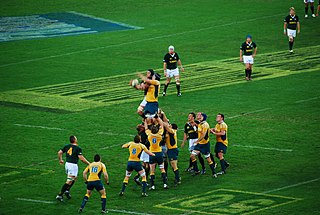
Winter Sports in Australia encompasses a great variety of activities across the continent of Australia, including winter sports played in snow and ice such as ice hockey. Climate varies considerably from the tropical North to temperate South in Australia, and sporting practices vary accordingly. Ice and snow sports like Skiing in Australia are conducted in the high country of the Australian Alps and Tasmanian Wilderness. Australia has relatively low mountain ranges, but a long history of participation in recreational skiing and the Winter Olympic Games. Australians have won olympic gold in ice skating, skiing and snow-boarding events. Australia's generally flat geography and usually mild winter climate otherwise provide ideal conditions for international non-snow/ice winter sports and team games like Rugby Union Football, Rugby league Football and Association Football (Soccer), which are all popular sports during the Australian winter and in which Australia has enjoyed considerable international success. Australian rules football is a home-grown winter football code with a wide following throughout Australia. Many other sports are also played or watched in Australia through the winter season.
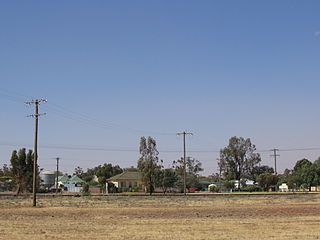
Grong Grong is a small town that is located in the Riverina region of New South Wales, Australia. The town is situated on the Newell Highway, 23 kilometres (14 mi) east of Narrandera in the Shire of Narrandera.
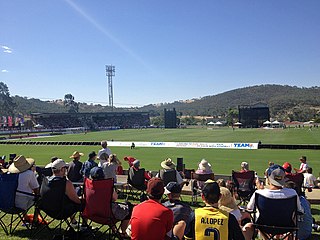
Lavington Sports Ground is a sports ground located in the suburb of Hamilton Valley near Lavington on the north-west fringe of the city of Albury, Australia. The oval is nestled in the side of a hill, with concrete terraces cut into the southern side of the oval below a grass embankment and the grandstand and changing rooms located on the north-west flank. The venue also incorporates a 4 table cricket wicket, a velodrome for track cycling and two netball courts. The Lavington Panthers Sports Club licensed club was formerly located next to the ground, across Hanna Street.

Australian rules football has been played in New South Wales since the 1870s; however it has a chequered history in the state and has generally been overshadowed in popularity as a winter sport by the rugby football codes. Compared to rugby league, Australian football had a small presence in Sydney until the 1980s. The sport is popular elsewhere in the state, and has been the dominant code in the Riverina and Broken Hill. Its popularity is constantly increasing northward, across what is known as the Barassi Line.
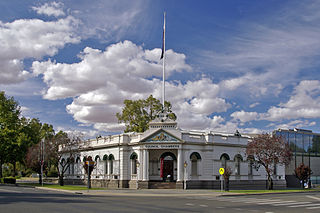
The Museum of the Riverina is a local history museum in Wagga Wagga, New South Wales, Australia. The Riverina is the region in south-western New South Wales in which Wagga Wagga is located. The museum was established by Wagga Wagga and District Historical Society in 1967 in premises near the Wagga Wagga Botanic Gardens on Lord Baden Powell Drive.
Sport in New South Wales describes participation in and attendance at organised sports events in the state of New South Wales in Australia. It is an important part of the culture of the state. In terms of participation, the most popular sports in the state are netball, tennis and soccer.

Pony Club Australia Ltd is a not for profit organisation that encourages people to ride and teaches them horsemanship and how to care for horses.

The Robertson Oval is a multi-use sports facility in Wagga Wagga, New South Wales, Australia. It primarily hosts cricket, Australian rules football and rugby league matches. A grass embankment runs around three-quarters of the oval with a 350-seat grandstand and social club on western side of the ground. Plans are in place for a 3–5 million dollar redevelopment of the arena. As the oval is located in the heart of Wagga Wagga CBD, the AFL and New South Wales Cricket Association will use the oval after redevelopment preferring it to other regional venues.
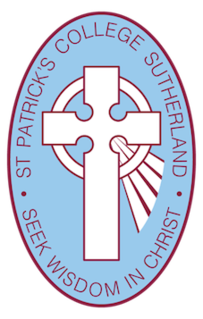
St Patrick's College is an independent Roman Catholic co-educational secondary day school, located in Sutherland, Southern Sydney, New South Wales, Australia. The College provides a general and religious education for students from Year 7 to Year 12.

The RMIT Redbacks are the sport collective of the Australian research University the Royal Melbourne Institute of Technology (RMIT), based at all campuses in Victoria and Ho Chi Minh City, Vietnam. The program is managed by the RMIT Sport team, part of RMIT Student Life.
The organisation of sport in Australia has been largely determined by its Federal system of government – Australian Government and six states and two territories governments and local governments. All three levels play an important role in terms of funding, policies and facilities. Each major sport is managed by a national sports organisation, with state counterparts that manage community sporting clubs. Umbrella or peak organisations represent the interests of sports organisations or particular sport issues. Education sector plays a small role through universities and schools. Private sector's involvement is extensive in professional sport through facilities, club ownership and finance/sponsorship.
Intellectual disability sport classification is a classification system used for disability sport that allows people with intellectual disabilities to fairly compete with and against other people with intellectual disabilities. Separate classification systems exist for the elite athlete with a disability side affiliated with the Paralympic movement and International Sports Federation for Persons with Intellectual Disability (INAS), and the sports for all model affiliated with Special Olympics. People with intellectual disabilities have issues with conceptual skills, social skills and practical skills. They have IQs lower than 75 points and their disability manifested and was documented prior to turning 18 years of age.























